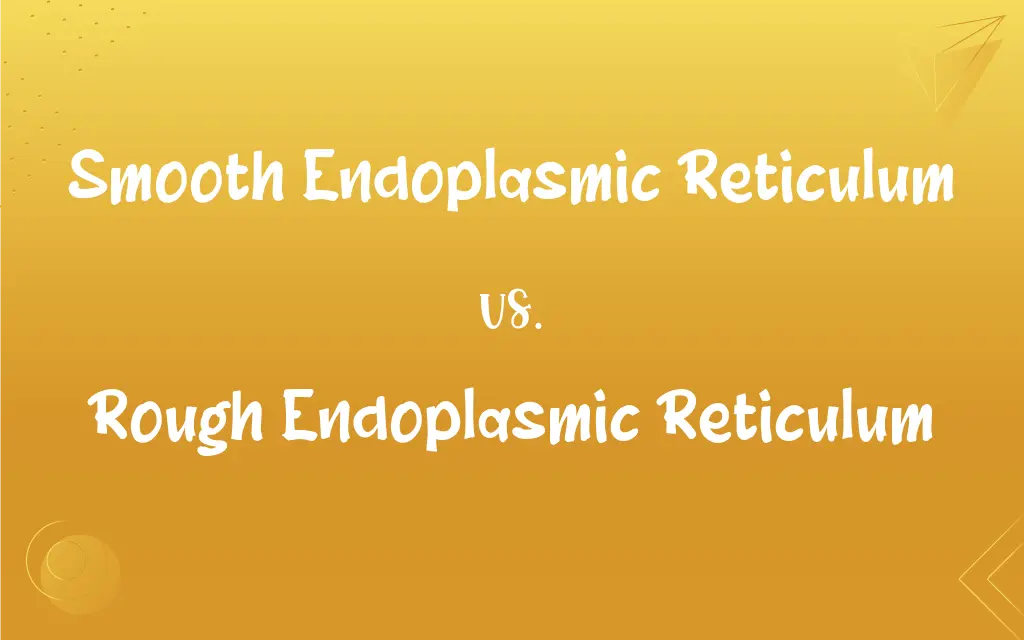Smooth Endoplasmic Reticulum vs. Rough Endoplasmic Reticulum: What's the Difference?
Edited by Aimie Carlson || By Harlon Moss || Updated on October 28, 2023
Smooth ER synthesizes lipids; rough ER is studded with ribosomes for protein synthesis.

Key Differences
The smooth endoplasmic reticulum (smooth ER) and rough endoplasmic reticulum (rough ER) are both parts of the cell’s endomembrane system. The smooth ER lacks ribosomes on its surface, giving it a smooth appearance. The rough ER is covered with ribosomes, giving it a rough texture.
Functionally, the smooth ER is primarily involved in lipid synthesis and metabolism, and in some cells, the detoxification of drugs and poisons. The rough ER is the site of protein synthesis for proteins destined for secretion or for the cell membrane.
In terms of structure, the smooth ER often appears as a network of tubules, while the rough ER is usually seen as a series of flattened sacs. The difference in structure reflects their different roles in the cell.
Cells that require a lot of lipid synthesis, like those in the liver, have an abundance of smooth ER. Conversely, cells that produce large amounts of proteins for export, like plasma cells, have extensive rough ER.
The smooth ER also plays a role in carbohydrate metabolism and calcium storage. In contrast, the rough ER is involved in the initial stages of protein glycosylation, a process of adding carbohydrate chains to proteins.
ADVERTISEMENT
Comparison Chart
Surface Texture
Lacks ribosomes, smooth surface.
Studded with ribosomes, rough appearance.
Primary Function
Lipid synthesis, metabolism, detoxification.
Protein synthesis for secretion or cell membrane.
Structural Appearance
Network of tubules.
Series of flattened sacs.
Cellular Abundance
Abundant in cells requiring lipid synthesis (e.g., liver cells).
Abundant in cells producing large amounts of proteins (e.g., plasma cells).
Additional Roles
Carbohydrate metabolism, calcium storage.
Initial stages of protein glycosylation.
ADVERTISEMENT
Smooth Endoplasmic Reticulum and Rough Endoplasmic Reticulum Definitions
Smooth Endoplasmic Reticulum
Part of the endomembrane system, lacks ribosomes.
Under the microscope, the smooth endoplasmic reticulum appeared as a series of tubules.
Rough Endoplasmic Reticulum
A cell organelle covered with ribosomes.
The rough endoplasmic reticulum was prominent in the secretory cell.
Smooth Endoplasmic Reticulum
Involved in carbohydrate metabolism.
In muscle cells, the smooth endoplasmic reticulum helps in carbohydrate metabolism.
Rough Endoplasmic Reticulum
Part of the endomembrane system, has a rough texture.
The ribosomes gave the rough endoplasmic reticulum its characteristic appearance.
Smooth Endoplasmic Reticulum
Plays a role in detoxifying drugs and poisons.
The smooth endoplasmic reticulum is essential in detoxifying harmful substances.
Rough Endoplasmic Reticulum
Proteins synthesized here are often glycosylated.
The rough endoplasmic reticulum played a key role in the initial glycosylation of proteins.
Smooth Endoplasmic Reticulum
A cell organelle involved in lipid synthesis.
The smooth endoplasmic reticulum was active in the liver cell.
Rough Endoplasmic Reticulum
Abundant in cells that produce many proteins.
Plasma cells, with their extensive rough endoplasmic reticulum, are efficient protein factories.
Smooth Endoplasmic Reticulum
Stores calcium ions in muscle cells.
The smooth endoplasmic reticulum's role in calcium storage is vital for muscle contraction.
Rough Endoplasmic Reticulum
Involved in protein synthesis.
Proteins destined for secretion were synthesized in the rough endoplasmic reticulum.
FAQs
What makes the smooth ER different in appearance from the rough ER?
The lack of ribosomes gives the smooth ER its smooth appearance.
What is the main function of the rough ER?
Protein synthesis for proteins destined for secretion or the cell membrane.
Can the functions of the smooth and rough ER overlap?
While their primary functions are distinct, there can be some overlap in roles.
Does the structure of the smooth ER vary in different cells?
Yes, it can appear as tubules or more interconnected structures.
Can both smooth and rough ER be found in the same cell?
Yes, many cells contain both types of ER.
Do all cells have the same amount of smooth and rough ER?
No, the amount varies depending on the cell's function.
Are ribosomes always attached to the rough ER?
Yes, ribosomes are what give the rough ER its rough texture.
Is the smooth ER involved in protein synthesis?
No, protein synthesis primarily occurs in the rough ER.
Does the amount of smooth ER change with cell activity?
Yes, it can increase with activities like detoxification.
Can the smooth ER transform into rough ER?
No, they are structurally and functionally distinct.
Can the smooth ER store calcium?
Yes, especially in muscle cells for muscle contraction.
Are both types of ER essential for cell survival?
Yes, both play crucial roles in the cell’s functions.
Is the amount of rough ER the same in all protein-producing cells?
No, it varies based on the cell's protein production needs.
Does the smooth ER participate in drug metabolism?
Yes, particularly in liver cells.
What is the primary role of the smooth ER in the liver?
Lipid metabolism and detoxification of drugs and poisons.
Can the rough ER be involved in lipid synthesis?
Not typically, as lipid synthesis is a primary function of the smooth ER.
Do all cells have rough ER?
Most cells do, especially those involved in protein production.
Can rough ER be found in non-secretory cells?
Yes, but in smaller quantities.
Can the rough ER function independently of the smooth ER?
While they have distinct functions, they are part of an interconnected system.
What is glycosylation and where does it occur?
It's the addition of carbohydrate chains to proteins, occurring in the rough ER.
About Author
Written by
Harlon MossHarlon is a seasoned quality moderator and accomplished content writer for Difference Wiki. An alumnus of the prestigious University of California, he earned his degree in Computer Science. Leveraging his academic background, Harlon brings a meticulous and informed perspective to his work, ensuring content accuracy and excellence.
Edited by
Aimie CarlsonAimie Carlson, holding a master's degree in English literature, is a fervent English language enthusiast. She lends her writing talents to Difference Wiki, a prominent website that specializes in comparisons, offering readers insightful analyses that both captivate and inform.































































